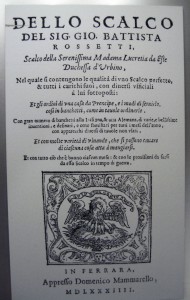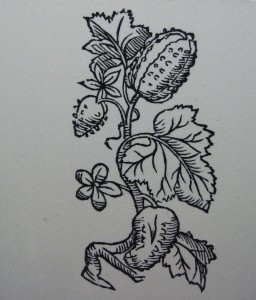- Native American eating “best museum cafeteria in town”. “Makes up for the museum,” sniffs Jeremy
- Catalog of advanced clones and improved varieties going like hot potatoes.
- The Economic Impact of Bioversity is apparently “a seriously problem-rich, solution-craving topic”. Innovation Investment Journal says so.
- Pharaonic palm not immortal. Medemia argun “critically endangered”.
- Goat lineage diversity delineated. Paywalled.
- Chickpea diversity includes variability in resistance to salinity. Paywalled.
Nibbles: Old fruit, Same fruit, Fruit juice, Dog breeding, Plant Cuttings, Seed storage, Romanian cattle breeds
- REALLY old fruit found in Chinese cellar.
- Marufo the same as Brujidera? Say it ain’t so!
- Rachel Laudan deconstructs a French depiction of cider-making. Well, someone had to.
- Genetic modification dates back to ancient Mexico.
- Rejoice, Plant Cuttings is out!
- Seeds of alpine plants don’t live as long as those of lower altitudes. So how many crop wild relatives are high-altitude species I wonder?
- Get your teeth into the work of the Transylvanian Rare Breeds Association.
Tough questions about agricultural research
First, has the decline in funding and the shift toward a breakthrough science model left us adequately prepared to solve the problems with our national and global food system? And second, would simply bolstering, as opposed to also broadening, our current system of agricultural research be an adequate response?
Us, in this case, being the US.
Paul B. Thompson, the W.K. Kellogg Chair in Agricultural, Food and Community Ethics at Michigan State University, had a great post in the run-up to Thanksgiving that I missed last week. He points out that Americans have been “disinvesting” in agricultural research and development over the past three decades, and that what investment there was has been “too narrowly focused on piecemeal adjustments in plant and animal genetics”.
Thompson then gives a run-down on the history of agricultural research in the US, and how it changed, especially in the wake of the Pound report in 1975. And despite the efforts of farm lobby groups, who fought to preserve the old system of land-grant universities and research, agricultural research and the ways it was funded altered in fundamental ways. Why? As Thompson notes of the USDA’s effective approach to solving farmers’ problems,
Despite its utility, however, this was not especially sexy science.
The analysis goes on to look at the rise in popularity of alternative “low-input methods such as organic, no-till, and poly-crop” approaches to farming, and at how, and why, these approaches have been so ill-served by research and research funding. What I find so remarkable is that Thompson’s detailed look at the USDA finds a mirror in research for poorer countries. Here’s what he has to say:
There is debate about these alternative approaches here in the United States, but there is really no debating the fact that poor farmers around the world could imitate many of [these] farming practices, given some adaptive research that tailors them to local soils and climate. In contrast, the more industrial approach requires two things that poor farmers lack. One is the infrastructure of local seed, fertilizer, and chemical companies, along with an effective regulatory system to monitor the impact of high-tech farming. The other is the money to buy these inputs from the private sector, even when they are available.
There is much more that repays a close reading; for example:
[T]he organic farming community’s attraction to vitalistic metaphors and unsubstantiated health-claims alienated many scientists whose careers depended upon pursuing a research program that could pass the laugh test. … [R]esearch focused on genomics and genetic engineering was much more promising to a budding scientist than the iffy strategy of partnering with the organic growers.
Lets forget about organic, for now, and the laugh test as a measure of scientific value, and see US scientists renew the old-fashioned approach to food and nutrition security, because clearly where US agriculture leads, the rest of the world follows.
Nibbles: Cancun, Wine, Zambia, Bees
- Just in time. Agriculture and Rural Development Day 2010 now has RSS.
- “It wasn’t debilitated in any way.” World’s oldest beer and wine drunk.
- Zambian farmers buy seeds, fertilisers and herbicides by mobile phone. What could possibly go wrong?
- Red bees! A little too much biodiversity to blame? h/t Tasting Cultures
Mystery plant; can you help?
To Ferrara for the weekend, and two plant ID mysteries.
 In the Castello di Ferrara — a wondrous building — is a room dedicated to court banquets and the like. It featured extracts from an early how-to guide, Giovanni Battista’s Dello Scalco, published in 1584. There were also enlargements of images to do with food and banquets. Actually, the entire castle exhibit made great use of enlarged images, which worked rather well, I thought. But I digress. Among the images was the one I reproduce below.
In the Castello di Ferrara — a wondrous building — is a room dedicated to court banquets and the like. It featured extracts from an early how-to guide, Giovanni Battista’s Dello Scalco, published in 1584. There were also enlargements of images to do with food and banquets. Actually, the entire castle exhibit made great use of enlarged images, which worked rather well, I thought. But I digress. Among the images was the one I reproduce below.
“Whisky foxtrot tango,” I thought to myself. What is it? Could it possibly be a horned melon, kiwano, or Cucumis metuliferus? Hard to say. But having taken a snap of that and the frontispiece of the book, I figured I’d be able to find out later. 1 It was not to be. Despite finding a gloriously usable scanned copy of the book, I couldn’t see any plates. And if it wasn’t from that book, I wasn’t sure where to look. Another manual from the same time didn’t have any plates either.
Of course I sent it to my friend Mr Peanut, who sent it to some of his cucurbit friends, and an answer may yet arrive. In the meantime, however, what can you tell me about it?
